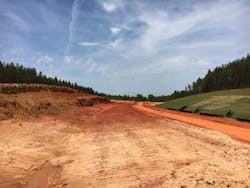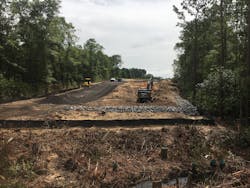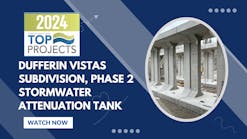The face of transportation is ever-changing. The needs and expectations of society combined with advancements in materials and automotive technology and safety have caused our roads and bridges to be nearly unrecognizable from their early Roman ancestors. Even the look of transportation infrastructure delivery has changed over the last several years.
The changes in the appearance of transportation construction sites were especially pronounced during the first half of 2020. Face coverings and physical distance have become almost as prevalent as hard hats and safety vests. As the diameter of a tailgate talk increases, so too does the diversity in color, age, culture, and gender identity among those contributing to project planning and implementation. For those that have been around the construction industry for a while, the changes can be staggering.How the work is performed is almost as fluid these days as who does the work and what the facility will be supporting. On some projects, one section may have been brought to near completion while another may not have even been cleared yet. Areas of “active construction” are no longer just areas of soil disturbance but instead are recognized by actual construction activity taking place in pursuit of completion. The clearing subcontractor may mobilize and demobilize several times before the project is completed. Crews constructing culverts or installing structural buildup of the roadway may be asked to do the same.
So, what’s going on? Why the shift in the way we’ve always done it?
Author David Brooks describes change in society this way: “Society changes when a small group of people find a better way to live, and the rest of us copy them.” Similarly, changes in how we build things begin with a disrupting event, expectation, or advancement in technology. Once a better way is discovered, it is maintained and promoted by those who have found benefit in that change.
The Alabama Department of Transportation (ALDOT) has been leading and forcing change in the area of construction stormwater management in Alabama and beyond for nearly 20 years. A culture of actively seeking positive change has been fostered by the leadership of past and current Transportation Directors and supporting leadership. A core value of “getting better every day” applies to more than just technical and operational matters. It is also expected in areas of how ALDOT treats people. An effective approach to managing construction stormwater called “The Five Pillars of Construction Stormwater Management” evolved at ALDOT as a result of this environment of encouraging leadership. This story is about the Five Pillars and one construction corridor that helped to refine and advance the concept, proving it practical and effective.Bloody 98
A section of US 98 that extends from the Alabama-Mississippi state line in southwest Alabama has become infamous over the last several decades. In the summertime, the route is part of a congested pilgrimage to the sugar-white shores of the Gulf Coast from areas in the West. In less crowded times, the route supports commuter and local traffic from several small communities that live and work in and around the city of Mobile, AL. The highway largely remains a two-lane rural facility with many driveways and traffic signals along its length.
This stretch of US 98 has been historically dangerous and lives up to its nickname, “Bloody 98,” as crash-related injuries and fatalities continue. In 2007, ALDOT began a series of construction projects to move the bulk of traffic to a safer, four-lane, divided interstate-like facility just north of the existing route. The first project was approximately 8 miles long, crossed many wetlands and streams, and required about 200 acres of soil disturbance. The project was split between two major watersheds: the Escatawpa River to the west and Big Creek to the east. Big Creek feeds Big Creek Lake, the drinking water source for over one-quarter of a million people in the Mobile area.
Muddy 98Trouble soon found the first construction project as the white sand beaches of the tannin-stained Escatawpa River became coated with a film of orange clay and Big Creek Lake lost its visual appeal as a source of water worth drinking. A string of missed opportunities to listen to a local canoe rental operator led to a series of negative stories in the local news. The publicity triggered regulatory investigations and fines, and legal complaints and suits. Project completion was delayed and funding for the future projects of the corridor was lost. The lonely completed section of the new route still sits vacant and unused over a decade later.
Regulatory compliance was ultimately regained and the initial project was completed under the watchful eyes of state and federal environmental regulators, the press, and an interested general public. Engineers representing lawyers and lawyers representing engineers weighed in on nearly every decision. The ordeal was painful for many and expensive for all. Along the way, the corridor earned a new nickname—Muddy 98.
The Search for Better Best Management Practices
A few years before Muddy 98, ALDOT began an earnest search for the very best Best Management Practices. The old rules of thumb and “the way we’ve always done it” simply weren’t working anymore. ALDOT was seeing a rise in project delays, negative public perceptions related to environmental stewardship, and real and indirect costs associated with both. ALDOT made a few key observations that, with the help of US 98, forever changed the face of ALDOT construction.
ALDOT came to accept that putting off doing the right things eventually leads to regulatory involvement, and that involvement typically leads to a loss of control while regulators force changes that may or may not make sense in a transportation setting. ALDOT shifted from a compliance continuum, where barely getting by had been the operating standard, to one of growth. Renewed commitments were made to the protection of the natural environment, to those communities and taxpayers who pay for transportation services, and to being open to change.
Evolution of the Five Pillars
The symptom of ALDOT’s problems—sediment—was the Department’s initial subject of focus, before concentrating on minimizing the detachment of soil particles to reduce sediment capture efforts. This was followed by an acceptance of the role of ownership and leadership. Managing work required an understanding that contractors are capable and willing to do almost anything if given proper direction and payment. ALDOT also realized that communication among all stakeholders is the best management practice.
Application of the Five Pillars
Funding required to redesign the remaining US 98 projects and restart construction was ultimately secured in 2018. To help manage the project, ALDOT reassembled part of the team that helped to regain regulatory compliance back in 2008. Two of the original team members now work for the infrastructure services firm Volkert, which provides CE&I (construction engineering and inspection) for the projects. Joey Fresolone serves as project manager for all of the projects and Barry Fagan assists with environmental quality assurance.
The Five Pillars of Construction Stormwater Management were polished and available by the time the projects were resurrected. Fagan, who helped to create the Five Pillars while working at ALDOT, helped with the awareness and application of the Five Pillars. They served as a touchstone during plan development and construction and helped to enhance communication efforts as new contractors were brought in and worked to complete each project.
Communication: Each new project begins with an effort to communicate the priorities and expectations of ALDOT for the project at hand. Pre-bid meetings, plan notes, special provisions, and training prepare bidders for the upcoming work and provide an opportunity to include any perceived extra costs in the bid package. Once the project is awarded, contractors and consultant CE&I staff engage in scheduled and ad-hoc communication and collaboration to ensure that the scope of work is fully delivered. Fresolone insists on conducting weekly coordination meetings and providing weekly status reports to stakeholders for each project.
Work: The project inspection staff and each contractor superintendent gather every Monday morning to discuss how best to accomplish the remaining work in a manner that is most protective of water quality. Contract requirements limit and delay soil disturbance. Once an area is disturbed, ALDOT and Fresolone expect continuous pursuit of final stabilization. Perhaps the most noticeable changes in the appearance of ALDOT construction projects are caused by this intentional shift in project phasing and sequencing.Water: A focus on managing water brings benefits to ALDOT, the environment, and the contractor. Contractors have found that properly managing water helps to minimize the work of managing erosion and makes efforts at managing sediment more effective. Current projects employ diversion berms, swales, water bars, and permanent conveyances and structures to direct where the water goes and how fast it gets there.
Erosion: As a part of the continuous pursuit of stabilization, solid sodding has become the vegetative cover of choice. Application requires an emphasis on achieving final configuration and grade, which requires an additional amount of care during earthmoving activities. However, the near-instant permanent stabilization and the ability to move on to new areas of the project with limited risk make sodding very attractive. It’s also fairly cost-effective when the need for temporary erosion control products, sediment control practices, and the maintenance associated with seeding and mulch are factored in.
Sediment: Volkert project staff and project contractors understand the benefits of slowed water. They know that as the velocity of runoff decreases, so does erosive energy and the capacity to transport sediments. Formal sediment basins are supplemented with temporary drainage sumps, and more traditional-looking aggregate, silt fence, and wattle barriers and checks. Flocculant is also utilized to assist with turbidity management.
The US 98 projects have proven themselves to be a model of environmental stewardship applied to linear transportation construction projects; they simply look different than some other projects. With continued vision and commitment to water quality, ALDOT, its consultants, and its contractors will continue to promote positive changes in how construction stormwater is managed in Alabama and across the United States.
References
Brooks, David. The Road to Character. Random House, 2015.











